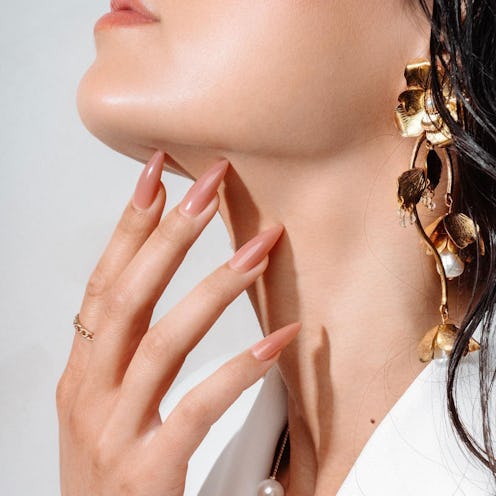(Nails)
The Type Of Gel Nail Polish You Choose Can Make Or Break Your Manicure
Nail artists explain.

There was once a time when choosing a nail polish shade was the only decision you had to make at your manicure appointment. Nowadays, nothing is as simple as deciding between a peachy nude or Barbie pink. Thanks to TikTok’s lightning algorithm, there is seemingly a new viral trend to try every other day, from almondetto nails to milk bath nails to watermelon nails. And while the endless manicure inspiration on your FYP adds an element of fun and customization to the experience of getting your nails done, the choices still go beyond shape and design. You can also upgrade your service with different types of gel nail polish.
With the promise of shiny, chip-free wear for up to two weeks, opting for gel can be worth the extra charge. But what’s the difference between different types of gel nails? Is Japanese soft gel from Japan? And what separates soft gel from hard gel? These are the burning questions many have when they find themselves at the salon.
To help clear the confusion so your finished manicure ends up exactly how you want it, TZR turned to three nail artists to set the record straight on the most popular gel polishes you’ll come across at salons.
What Are The Different Types Of Gel Nail Polish?
When you step into a nail salon, you’ll encounter various types of colored gels, each with distinct consistencies and pigment ratios, designed for different applications. Primarily, two main options stand out: soft gel nails, which can be soaked-off, and hard gel, which requires drilling/filing for removal. Morgan A. Dixon, nail artist and founder of M.A.D. Nails in New Orleans, highlights that, “Soft gel nails are a more natural gel option, suitable for lighter wear. Hard gel nails are best for those who subject their nails to more wear and tear, seeking longer-lasting results and fill-ins.”
Soft Gel Nail Polish
The most common option is regular gel polish, which can be found in most nail salons. Nail artist San Sung Kim explains, “Regular gel is simply the matter of using a gel nail polish.” Ideal for individuals seeking a straightforward manicure with extended wear, it should last over two weeks. It’s perfect for those aiming to avoid chipped nails or lengthy drying times. However, Dixon notes, “They feel lighter and more natural, so if you’re rough on your nails, they might not last as long as desired.”
Japanese soft gels present another choice — high-quality formulas crafted in Japan. Kim mentions, “They’re often richly pigmented and possess the perfect consistency for full-color nails or intricate art.” These gels typically come in pots, requiring a separate nail brush for application, which can take some time. This precision enables artists to have maximum control over the product’s application. One thing to note is that they’re more expensive as they are imported.
There’s also Korean soft gel, which is a product from Korea. “In my experience, these formulas are very similar to Japanese gel, from the packaging to the product application to the wear. I find it to be thicker and more pigmented than domestic gel brands," says manicurist Mazz Hanna.
Structured soft gel is another common sight, which essentially entails soft gel with additional layers for reinforcement, according to Dixon. Kim explains, "Structured soft gel strengthens and supports the nail. Nail technicians can create an apex and overall structure, allowing natural nails to grow without vulnerability to damage or breakage." They are also great for building a smooth surface on the dented part of nail beds, adding strength to cracked nails, and can also be used for nail extensions.
According to Kim, “Soft gels can easily be removed by filing the top layer and soaking them off with acetone.” Both regular gel polish, Japanese gel, Korean gel, and structured gel can be removed by filing off the top coat and soaking in 100% acetone. Although, sometimes, structured gel may not soak off properly and will require more filing to remove.
Hard Gel Nail Polish
Another option to spring for at the salon is hard gel, which is just that, a product that has less flexibility than soft gel. “Unlike soft gel, hard gel isn't meant to be removed, but rather refilled and/or built upon,” explains Hanna. Many people only think of acrylic when they want to add an extension, when it simply isn’t the case. Hard gel is a great option for people who have long natural nails and want to add strength with a gel overlay, or sculpting extensions. “My favorite hard gel is ORLY Builder in a Bottle — the formula is the best I've tried, and the bottle application (opposed to a pot) makes it super easy to apply,” adds Hanna.
Hard gel nails provide strength and structure but can only be removed by filing them off with a nail file or e-file, as explained by Kim. If you want to take off hard gel, it’s recommended to see a professional.
What To Know Before Your First Gel Manicure Appointment
When it comes to gel polish, there’s a wide variety in both price and quality. Some options offer greater longevity, while others focus on strengthening natural nails. Therefore, it’s crucial to choose a salon you trust that provides high-quality choices. The cost of gel varies considerably depending on where you are located. But Hanna says the average cost of a basic gel manicure is between $50-$70 for a single color. Hard gel is usually between $80-$150 depending on whether it’s an overlay or extensions and where you’re going to get your nails done.
It’s important to note that gels are not damaging to nails; however, it's crucial to have a proper way to remove them, avoid filing down too far, and use quality products along with clean tools. And whatever you do, do not pick or peel the polish off!
This article was originally published on